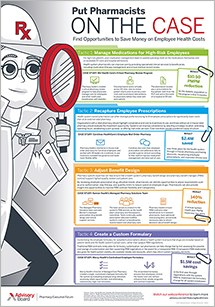Auto logout in seconds.
Continue LogoutCVS Health on Wednesday unveiled a new tool designed to help pharmacists and customers compare drug prices and purchase lower-cost options at the point of sale.
Upcoming webconference: 5 things you need to know about specialty pharmacy strategy
CVS' new tool is expected to increase pressure on drugmakers to reduce prescription costs, Forbes reports—pressure that drugmakers are already feeling from both consumers and the Trump administration.
How it works
The Rx Savings Finder will show pharmacists on an interactive screen whether a customer's prescription is part of their health plan formulary and whether that drug is the least-costly option available.
If the program finds a less-costly equivalent to the customer's prescription, it will notify the pharmacist, who will in turn tell the patient and, pending permission from the patient, ask the patient's doctor if the prescription can be switched.
Pharmacists will also be able to check for other potential approaches to cost savings, such as coupons or whether a 90-day prescription would be cheaper than a 30-day one. The savings finder also will be made available to customers via an app, according to CVS.
The effort expands upon one CVS launched last year, which uses to EHRs to give providers access to patient-specific drug costs and lower-cost alternatives. CVS said that fewer than 10,000 doctors use the Real-Time Benefits tool, but those who do switched patients from a non-covered drug to a covered one 85% of the time. In cases where the prescribed drug is covered but there is a lower-cost option, prescribers switched to the lower-cost drug 30% of the time, according to CVS. Patients who had their prescription changed to a lower-cost option saved on average $75.
Kevin Hourican, EVP of retail pharmacy for CVS Health, touted the new tool in a statement, saying that it will allow the company's more than 30,000 pharmacists to "play an important role by helping patients save money on their medications, providing advice on how and when to take them, and ultimately helping them achieve better health outcomes" (Japsen, Forbes, 4/11; Johnson, "Wonkblog," Washington Post, 4/11; Bannow, Modern Healthcare, 4/11).
Upcoming webcon: 5 things you need to know about specialty pharmacy strategy
Learn how the specialty pharmacy landscape is changing and what health systems must do to manage care around these high-cost drugs.
Don't miss out on the latest Advisory Board insights
Create your free account to access 1 resource, including the latest research and webinars.
Want access without creating an account?
You have 1 free members-only resource remaining this month.
1 free members-only resources remaining
1 free members-only resources remaining
You've reached your limit of free insights
Become a member to access all of Advisory Board's resources, events, and experts
Never miss out on the latest innovative health care content tailored to you.
Benefits include:
You've reached your limit of free insights
Become a member to access all of Advisory Board's resources, events, and experts
Never miss out on the latest innovative health care content tailored to you.
Benefits include:
This content is available through your Curated Research partnership with Advisory Board. Click on ‘view this resource’ to read the full piece
Email ask@advisory.com to learn more
Click on ‘Become a Member’ to learn about the benefits of a Full-Access partnership with Advisory Board
Never miss out on the latest innovative health care content tailored to you.
Benefits Include:
This is for members only. Learn more.
Click on ‘Become a Member’ to learn about the benefits of a Full-Access partnership with Advisory Board
Never miss out on the latest innovative health care content tailored to you.

